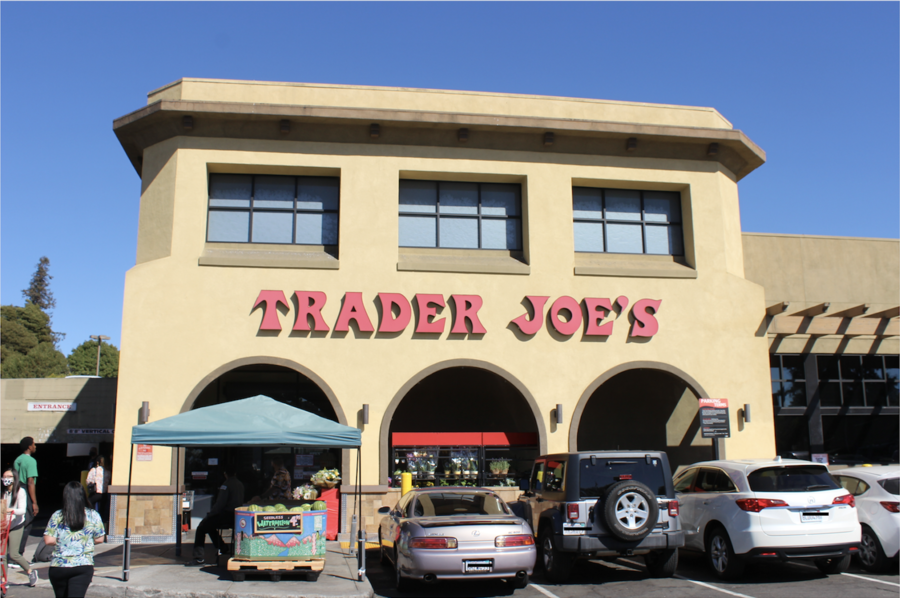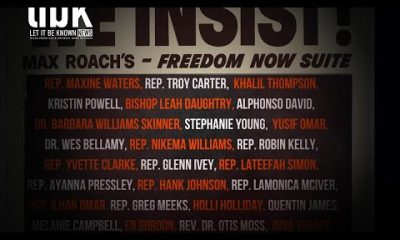Bay Area
Large Grocery Stores End Hazard Pay in Oakland, Berkeley
Immediately after Oakland and Berkeley reached the yellow tier of COVID-19 spread, as state restrictions like capacity limits lifted, and as the Delta variant continued to spread, positive cases of the virus began to trend upward. A chart showing data collected by Alameda County shows that when the county entered the yellow tier on June 8, the total cases from the previous 14 days was 455. Toward the end of July, this 14-day total passed 4,000 cases on three consecutive days, which was about a ninefold increase.

Workers in four different chain grocery stores in Oakland, Berkeley and Emeryville told The Oakland Post that they are not receiving hazard pay related to the COVID-19 pandemic.
While Oakland and Berkeley city councils each unanimously passed ordinances last February that required large grocery stores to pay workers an additional $5 per hour due to COVID-19 hazards, both ordinances stated that once the cities reached the yellow tier — that indicating minimal COVID-19 spread — this requirement would end.
Workers in Whole Foods, Grocery Outlet and Trader Joe’s based in either Oakland or Berkeley reported that they received their last hazard paychecks in early July, about a month after these cities reached the yellow tier on June 8.
The Oakland Post contacted Oakland City Council President Nikki Fortunato Bas, who wrote The Grocery Store Worker Hazard Pay Emergency Ordinance, to ask about hazard pay ending. Bas’s chief of staff, Miya Saika Chen responded by acknowledging that since the ordinance “was tied to state guidelines determining safe reopening,” and Oakland had reached the yellow tier, the ordinance no longer applies.
Immediately after Oakland and Berkeley reached the yellow tier of COVID-19 spread, as state restrictions like capacity limits lifted, and as the Delta variant continued to spread, positive cases of the virus began to trend upward. A chart showing data collected by Alameda County shows that when the county entered the yellow tier on June 8, the total cases from the previous 14 days was 455. Toward the end of July, this 14-day total passed 4,000 cases on three consecutive days, which was about a ninefold increase.
In response to questions about hazard pay ending as COVID-19 cases increased, Chen emphasized the impact of vaccination, as vaccines have been effective in preventing serious health effects related to the virus.
“Our top priority must be to ensure everyone has accurate information about the vaccines and safe and equitable access to the vaccines in order to prevent another wave of infections,” she said.
Neither Bas nor any members her staff responded when asked if there was anything council could do or is planning to do to reinstate grocery store hazard pay. The Oakland Post posed the same question to Berkeley City Councilmember Terry Taplin, who wrote Berkeley’s hazard pay ordinance. He responded by saying that to reinstate grocery store hazard pay, Berkeley’s City Council would have to pass a new ordinance.
“The city is currently evaluating several options to respond to the Delta variant,” Taplin said. “I will have to consult with the city team and legal to discuss what can be done around new hazard pay.”
In Oakland and Berkeley, new hazard pay ordinances cannot be passed this month through City Council actions, as council meetings in both cities are on hold through August. But both Oakland and Berkeley City Councils could revisit the issue in September when meetings start up again. The grocery store workers who The Oakland Post spoke to felt they deserved hazard pay due to their hard work during the COVID-19 pandemic.
“[The hazard pay] was so helpful,” said a Whole Foods worker in Berkeley. “It’s so expensive to live here and I can barely make it. I was able to put a little money away and not penny-pinch when I was getting it.”
Like all workers interviewed for this article, this worker feared retaliation from their employers for speaking to the press about their pay, and asked not to be named.
Furthermore, with temperature checks suspended, the Berkeley Whole Foods worker said they did not feel safe at work. They also claimed that in May there was an outbreak of the virus in the prepared foods section of their store. Although The Oakland Post contacted Whole Foods to ask about hazard pay, temperature checks, and the alleged COVID-19 outbreak, their media team has not responded.
The City of Emeryville, which borders both Oakland and Berkeley, has never required any grocery stores to offer its employees COVID-19 hazard pay. A worker at a Pak ’N Save in Emeryville, who has been on the job for about a year, said they were being paid Emeryville’s minimum wage, which is currently $17.13, and has never received any hazard pay. They said low pay has hit some of their co-workers with families especially hard. Children sometimes wait in the Pak ’N Save break room during shifts as the pay rates make it impossible for some grocery store workers to afford childcare.
“They are paying us the lowest they are literally allowed to pay us,” the Pak ’N Save worker said. “A lot of people are sick of it. A lot of people are quitting.”
Wendy Gutshall, a spokesperson for Safeway, the company that owns and operates Pak ’N Save, confirmed that the Emeryville store has not been paying hazard pay and that Safeway stores in Oakland and Berkeley stopped paying the $5 hazard pay after those cities reached the yellow tier. Gutshall said Safeway and Pak ’N Save paid workers an extra $2 an hour in hazard pay from March through June 13 of 2020 and gave a bonus to their frontline workers last December.
Although they have not currently been receiving hazard pay, workers at Pak ’N Save in Emeryville have faced exposure to COVID-19. Emails this Pak ’N Save worker shared with The Oakland Post from a Regional Human Resources Manager indicate that between July 21 and July 28, workers had been exposed to COVID-19 three separate times in the store.
This same worker shared a photo of a letter the store displayed in its break room indicating that one of their co-workers recently filed a complaint with State of California’s Dept. of Industrial Relations accusing the store of making them work for several days after they reported experiencing COVID-19 symptoms due to the store being short staffed.
When asked about the complaint, Gutshall said she could not speak to it directly, stating “For privacy reasons, we cannot provide specifics regarding a [worker’s] situation.” She said workers experiencing COVID-19 symptoms are instructed to go home, that the company is in close contact with such workers to investigate their contacts with other workers and ensure they receive appropriate medical care, and that such workers can access 80 hours of quarantine pay.
According to Gutshall, workers are required to check their temperature when reporting for work at Pak ’N Save and Safeway. The Pak ’N Save worker The Oakland Post interviewed said such temperature checks are optional at the store where they worked.
Both the Pak ’N Save worker and the Whole Foods worker that The Oakland Post interviewed said that as the pandemic has dragged on, increasing numbers of their co-workers have quit, which has caused their workload to intensify and increase.
“Everyone has to do a little bit of everything,” the Pak ’N Save worker said. “We don’t have enough checkers or enough people who walk around the store to help customers and clean up. But [Pak ‘’N Save] is not even willing to increase wages to meet the need for labor.”
“The work is just getting more and more stressful,” said the Whole Foods worker. “We’re running on a skeleton crew. And now we’re back to regular pay.”
Bay Area
Chevron Richmond Installs Baker Hughes Flare.IQ, Real-time Flare Monitoring, Control and Reduction System
While the sight of flaring can cause concern in the community, flares are essential safety systems that burn pollutants to prevent them from being released directly into the atmosphere. They activate during startup and shut-down of facility units or during upsets or equipment malfunctions. The typical flare stack is about 200 feet high so that vapors are well above street levels.

The Richmond Standard
Chevron Richmond recently installed flare.IQ, a real-time, automated system that will improve the facility’s flaring performance.
The technology, developed by Panametrics, a Baker Hughes business, uses sensors to monitor, reduce and control flaring in real time. It collects and assesses data on refinery processes, such as temperature, pressure, gas flow and gas composition, and adjusts accordingly to ensure flares burn more efficiently and cleanly, leading to fewer emissions.
“The cleaner the flare, the brighter the flame can look,” said Duy Nguyen, a Chevron Richmond flaring specialist. “If you see a brighter flame than usual on a flare, that actually means flare.IQ is operating as intended.”
While the sight of flaring can cause concern in the community, flares are essential safety systems that burn pollutants to prevent them from being released directly into the atmosphere. They activate during startup and shut-down of facility units or during upsets or equipment malfunctions. The typical flare stack is about 200 feet high so that vapors are well above street levels.
“A key element in Baker Hughes’ emissions abatement portfolio, flare.IQ has a proven track record in optimizing flare operations and significantly reducing emissions,” said Colin Hehir, vice president of Panametrics, a Baker Hughes business. “By partnering with Chevron Richmond, one of the first operators in North America to adopt flare.IQ, we are looking forward to enhancing the plant’s flaring operations.”
The installation of flare.IQ is part of a broader and ongoing effort by Chevron Richmond to improve flare performance, particularly in response to increased events after the new, more efficient hydrogen plant was brought online in 2019.
Since then, the company has invested $25 million — and counting — into flare minimization. As part of the effort, a multidisciplinary refinery team was formed to find and implement ways to improve operational reliability and ultimately reduce flaring. Operators and other employees involved in management of flares and flare gas recovery systems undergo new training.
“It is important to me that the community knows we are working hard to lower emissions and improve our flaring performance,” Nguyen said.
Also evolving is the process by which community members are notified of flaring incidents. The Community Warning System (CWS), operated by Contra Costa County is an “all-hazard” public warning system.
Residents can opt-in to receive alerts via text, e-mail and landline. The CWS was recently expanded to enable residents to receive notifications for “Level 1” incidents, which are considered informational as they do not require any community action.
For more information related to these topics, check out the resources included on the Chevron Richmond, CAER and Contra Costa Health websites. Residents are also encouraged to follow @chevronrichmond and @RFDCAOnline on Facebook and X (formerly Twitter), where additional information may be posted during an incident.
Activism
Oakland Hosts Town Hall Addressing Lead Hazards in City Housing
According to the city, there are 22,000 households in need of services for lead issues, most in predominantly low-income or Black and Latino neighborhoods, but only 550 to 600 homes are addressed every year. The city is hoping to use part of the multimillion-dollar settlement to increase the number of households served each year.

By Magaly Muñoz
The City of Oakland’s Housing and Community Development Department hosted a town hall in the Fruitvale to discuss the efforts being undertaken to remove lead primarily found in housing in East and West Oakland.
In 2021, the city was awarded $14 million out of a $24 million legal settlement from a lawsuit against paint distributors for selling lead-based paint that has affected hundreds of families in Oakland and Alameda County. The funding is intended to be used for lead poisoning reduction and prevention services in paint only, not water or other sources as has been found recently in schools across the city.
The settlement can be used for developing or enhancing programs that abate lead-based paint, providing services to individuals, particularly exposed children, educating the public about hazards caused by lead paint, and covering attorney’s fees incurred in pursuing litigation.
According to the city, there are 22,000 households in need of services for lead issues, most in predominantly low-income or Black and Latino neighborhoods, but only 550 to 600 homes are addressed every year. The city is hoping to use part of the multimillion-dollar settlement to increase the number of households served each year.
Most of the homes affected were built prior to 1978, and 12,000 of these homes are considered to be at high risk for lead poisoning.
City councilmember Noel Gallo, who represents a few of the lead-affected Census tracts, said the majority of the poisoned kids and families are coming directly from neighborhoods like the Fruitvale.
“When you look at the [kids being admitted] at the children’s hospital, they’re coming from this community,” Gallo said at the town hall.
In order to eventually rid the highest impacted homes of lead poisoning, the city intends to create programs and activities such as lead-based paint inspections and assessments, full abatement designed to permanently eliminate lead-based paint, or partial abatement for repairs, painting, and specialized cleaning meant for temporary reduction of hazards.
In feedback for what the city could implement in their programming, residents in attendance of the event said they want more accessibility to resources, like blood testing, and information from officials about lead poisoning symptoms, hotlines for assistance, and updates on the reduction of lead in their communities.
Attendees also asked how they’d know where they are on the prioritization list and what would be done to address lead in the water found at several school sites in Oakland last year.
City staff said there will be a follow-up event to gather more community input for programming in August, with finalizations happening in the fall and a pilot launch in early 2026.
Alameda County
Oakland Begins Month-Long Closure on Largest Homeless Encampment
At 8 a.m. sharp, city workers began piling up trash and dismantling makeshift homes along the nearly five-block encampment. City crews blocked off streets from 14th Ave to 17th Ave, between E. 12th and International Blvd, due to the Safe Work Zone Ordinance that was passed by the city council in 2022 to protect workers from harassment during cleanings, according to a city spokesperson.

By Magaly Muñoz
The City of Oakland began a three-week-long breakdown of the largest homeless encampment in the city on E. 12th Street on Monday morning. Residents and advocates said they are devastated about the displacement of dozens of people.
At 8 a.m. sharp, city workers began piling up trash and dismantling makeshift homes along the nearly five-block encampment. City crews blocked off streets from 14th Ave to 17th Ave, between E. 12th and International Blvd, due to the Safe Work Zone Ordinance that was passed by the city council in 2022 to protect workers from harassment during cleanings, according to a city spokesperson.
Jaz Colibri, one of the many advocates at the closure, said the encampment sweeps were “intense and terrifying” to witness. They claimed that several residents, many of them non-English speakers, had not been aware that the sweep was happening that day because of a lack of proper communication and outreach from Oakland.
Colibri added that the city had done a Census “many months ago” and “had not bothered to count people since then”, meaning dozens of individuals have missed out on housing and resources in the last few weeks because the city doesn’t offer outreach in multiple languages.
“Basically, [Oakland] dropped the ball on actually getting to know everybody who lives here and then creating a housing solution that meets everyone’s needs,” Colibri said.
City spokesperson Jean Walsh told the Post that notices of the closure operation were posted in Spanish and Chinese prior to Monday, but did not clarify if outreach was done in those languages as well.
Nearly a dozen Oakland police vehicles, California Highway Patrol officers, and Oakland Public Works staff were gathered along E 12th waiting for residents to pack up their belongings and move away from the area.
Advocates said residents “felt unsafe” due to the hefty law enforcement presence.
One city worker, who was picking up debris near 16th Ave, said, “They’ve known we were coming for a long time now” in reference to resident confusion about the sweeping.
The state doubled down on its requirement to get cities and counties to deal with their homelessness crisis at a press conference Monday afternoon. Gov. Gavin Newsom’s office released a “model ordinance” that is intended to provide a starting point that local municipalities can use to build from and adjust in creating their own policies on encampments, if they haven’t done so yet.
Newsom said “No more excuses, time to deliver” after the state has poured hundreds of millions of dollars into solving the issue.
Oakland was awarded a $7.2 million grant from the state in 2024 to close long-standing encampments in the city, including camps at Martin Luther King, Jr. and 23rd Street, and Mosswood Park.
Residents at these encampments were offered wraparound supportive services, temporary shelter, and eventually will be transitioned to permanent supportive housing, according to a city statement from last year.
Residents who accepted housing at these three encampments were moved into newly acquired property, formerly the Extended Stay America Hotel in West Oakland, which will first serve as interim housing for up to 150 individuals and couples in 105 units, and in the coming year, will be converted into 125 units of permanent housing.
Walsh said as of May 2, “32 residents of the recently closed Mosswood Park encampment moved into the Mandela House program” and as of May 12, “41 residents of the East 12th Street encampment have already accepted offers to move to the Mandela House.” The city will provide final numbers of how many accepted and moved into housing after the closure operation is over.
-

 Activism4 weeks ago
Activism4 weeks agoAI Is Reshaping Black Healthcare: Promise, Peril, and the Push for Improved Results in California
-

 Activism4 weeks ago
Activism4 weeks agoBarbara Lee Accepts Victory With “Responsibility, Humility and Love”
-

 Activism4 weeks ago
Activism4 weeks agoESSAY: Technology and Medicine, a Primary Care Point of View
-

 Activism4 weeks ago
Activism4 weeks agoNewsom Fights Back as AmeriCorps Shutdown Threatens Vital Services in Black Communities
-

 Activism4 weeks ago
Activism4 weeks agoFaces Around the Bay: Author Karen Lewis Took the ‘Detour to Straight Street’
-

 Arts and Culture4 weeks ago
Arts and Culture4 weeks agoBOOK REVIEW: Love, Rita: An American Story of Sisterhood, Joy, Loss, and Legacy
-

 #NNPA BlackPress4 weeks ago
#NNPA BlackPress4 weeks agoThe RESISTANCE – FREEDOM NOW
-

 Alameda County4 weeks ago
Alameda County4 weeks agoOUSD Supt. Chief Kyla Johnson-Trammell to Step Down on July 1


















































